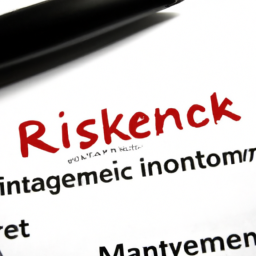
Risk Management: Protecting Your Business from Uncertainties
Introduction
In today’s rapidly changing business landscape, risk management has become an essential practice for organizations of all sizes. Whether you’re a startup or a well-established company, understanding and mitigating risks can help safeguard your business from potential threats and uncertainties. This article aims to provide an overview of risk management and highlight its importance in ensuring business continuity and success.
What is Risk Management?
Risk management is the process of identifying, assessing, and prioritizing potential risks that could negatively impact an organization’s objectives. It involves developing strategies and implementing measures to minimize or eliminate these risks, allowing businesses to make informed decisions and protect their interests.
The Importance of Risk Management
Implementing a robust risk management framework offers several benefits to businesses:
1. Protecting Assets: By identifying and addressing potential risks, organizations can protect their assets, including physical resources, intellectual property, and financial investments.
2. Business Continuity: Effective risk management ensures that businesses can continue their operations even in the face of unexpected events or crises. By being prepared, organizations can minimize downtime and maintain productivity.
3. Enhanced Decision Making: Understanding the potential risks associated with different courses of action allows businesses to make informed decisions. Risk management provides valuable insights that enable organizations to weigh the potential rewards against the associated risks.
The Risk Management Process
The risk management process typically involves the following steps:
1. Identify Risks: The first step is to identify potential risks that could impact the organization’s objectives. This can be done through brainstorming sessions, analyzing historical data, conducting risk assessments, and engaging with relevant stakeholders.
2. Assess Risks: Once risks are identified, they need to be assessed in terms of their likelihood and potential impact. This step helps prioritize risks based on their severity and allows organizations to allocate resources accordingly.
3. Develop Risk Mitigation Strategies: After assessing risks, organizations should develop strategies to mitigate or manage them effectively. This may involve implementing preventive measures, creating contingency plans, or transferring risks through insurance or contracts.
4. Implement and Monitor: The next step is to implement the identified risk management strategies. Regular monitoring and review are crucial to ensure that the implemented measures remain effective and to identify new risks that may arise.
5. Review and Improve: Risk management is an ongoing process that requires periodic reviews and improvements. Organizations should learn from past experiences, adapt their strategies, and stay proactive in identifying emerging risks.
Conclusion
In an unpredictable business environment, risk management is a vital practice for organizations aiming to safeguard their interests and ensure long-term success. By identifying and mitigating potential risks, businesses can protect their assets, maintain continuity, and make informed decisions. Implementing a robust risk management framework empowers organizations to navigate uncertainties with confidence and resilience.